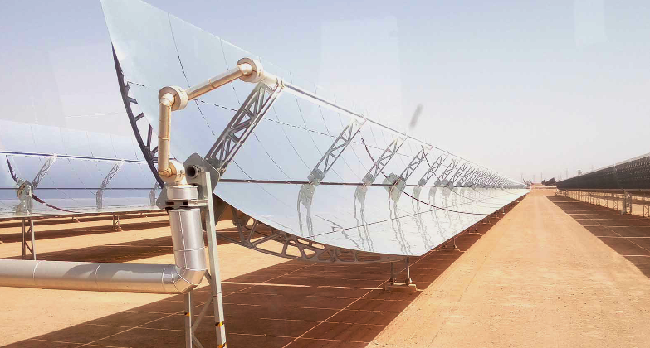
Morocco takes lead with world’s largest solar plant
Morocco, in the north-western corner of Africa, has not only made a dedicated effort to provide about half of its electricity needs from renewable energy by 2020, but also currently boasts of the largest solar plant in the world.
Advertisement
Rows and rows of neatly arranged 500,000 arc-shaped shiny silver metals fitted with mirrors glitter in the hot sunlight like soldiers on an inspection parade and move in formation to follow the sun’s movement like a well-rehearsed military band.
One of the biggest energy fields in the world, estimated to cost over $9 billion, is called the Noor Solar Power Complex and stretches for several kilometres on a land space of 3,000 hectares across five sites close to the Ouarzazate, Midelt, Laâyoune, Boujdour and Tata communities.
The complex also consists of cooling towers, water treatment tanks, thermal energy storage tanks, heat transfer fluid (HTF) pumping station and a turbine and electrical evacuation centre. An administrative building is also manned by the NOMAC Company which employs some 59 Moroccan technicians and staff.
For a country that currently imports 94 per cent of its power needs as fossil fuels from abroad that sometimes attract subsidies, the gargantuan project, to be complemented by wind and hydro power, is intended to give a very huge respite to Morocco by supplying power to over one million homes by 2020.
The complex consists of four plants and will have an installed capacity of 580 mw when completed. Two of the plants are based on CSP parabolic mirrors; the third is a solar tower plant and the fourth is based on photovoltaic technology.
Noor I to Noor IV
The four plants have been named Noor I to Noor IV and are still under construction by a team of local and foreign companies, with Acwa Power as the main developer.
The first part of the complex, the Noor I, which is about 10km from the city of Ouarzazate within the community of Ghessate in Morocco, covers only 480 hectares of the total area, with the solar field taking about 98 per cent of the plant area.
Started in 2013, Noor I has a gross capacity of 160 MW, a thermal storage of three hours and is being financed with a concessional loan of €730 million.
Noor II, which was begun in 2015 and occupies 680 hectares, has a gross capacity of 200 MW, a thermal storage of seven hours and is being constructed with a mobilised concessional financing of €810.
Noor III, which was also started in 2015, occupies a land space of 750 hectares but has a smaller capacity of 150 MW, a thermal storage of eight hours, and is being constructed with a mobilised concessional funding of €645 million.
On the other hand, Noor IV, which has the smallest capacity of 70 MW occupies 210 hectares but its developer is yet to be firmed up. The total mobilised concessional funding of the first three phases is, however, €2185 billion.
On a recent visit to the solar complex, a team of 26 African journalists saw workers busily working in the sometimes very scorching sun, just to complete work on all the plants by 2017.
Jobs created
As a result of the construction, 1,800 direct jobs have been created, including 1,400 for Moroccans, half of whom are indigenes from the Ouarzazate region.
Energy plan
His Majesty Mohammed VI, the King of Morocco, inaugurated the first phase of the project (Noor I) in Ouarzazate on Thursday, February 4, 2016, and ultimately it is expected that the country’s renewable programme will save 3.7 million tons of CO2 emissions every year.
Morocco has embarked on projects that will allow it to realise its vision with quantified targets: increase the share of its renewable energy to 42 per cent by 2020 and improve energy efficiency by 12 per cent by 2020.
In 2030, the share of electricity produced from renewable energy sources is targeted to reach 52 per cent in Morocco.
An agency dedicated to renewable energies and energy efficiency (ADEREE) and the National Agency for Solar Energy (MASEN) have, therefore, been created to make this dream achievable, while legislation regarding renewable energy and energy efficiency, as well as a dedicated fund, has also been put in place.
Wind parks
Adding to the 580 MW from the solar plant is the Moroccan wind power plan which aims to establish 2,000 MW of capacity by 2020 and allow an annual production that corresponds to 26 per cent of the current electricity production in the kingdom. This is also intended to prevent the emission of 5.6 million tons of CO2 each year.
The sites identified for the wind plan are Tangier, Jbel Lahdid, Taza, Midelt, Tiskrad and Boujdour and the projects are expected to take off between 2017 and 2020.
The existing wind parks of Tantan (2013), Tarfaya (2015), Laayoune (2013) Tangier (2010) Essaouira (2007) generate 101.87 MW, 300 MW, 50.6 MW, 140 MW and 60 MW, respectively.
Writer’s email: [email protected]



